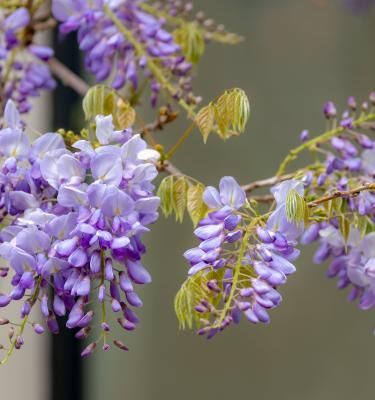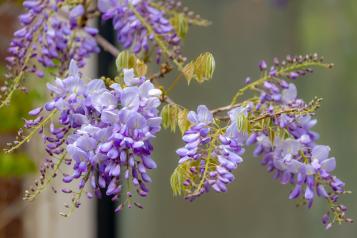

How to grow and care for wisteria
Wisteria is one of the most stunning climbers, famous for its cascading blooms and gorgeous scent, and twirling habit. In shades of purple, pink and white, wisteria can transform drab walls, fences, pergolas, or arches into something truly magical.
Just give them a little bit of love and you’ll be rewarded with stunning blooms all season long.
Top tips for growing wisteria
-
Wisteria loves the sun. Make sure it gets 6 hours of sunshine a day.
-
Go for grafted if you want big blooms. They flower sooner and they’re a little more reliable than seed grown.
-
For a happy wisteria vine, feed with a flowering shrub or rose fertiliser.
-
Don’t be afraid to give your wisteria the occasional haircut. A trim in summer and winter will keep your plant looking tidy and terrific.

Types of wisteria vine
The two main species of wisteria you’ll find are:
-
Chinese Wisteria: A strong grower, and great for large areas. This drama-queen will shoot out masses of flowers before you see any leaves.
-
Wisteria Floribunda: A little more compact, and great for small spaces. You’ll get flowers and leaves at the same time.
Buying wisteria
Go for grafted plants rather than seed-raised ones. Grafted wisterias bloom at a younger age. Seed-raised can take years. And when they do flower? It can be a little underwhelming.
Not sure what to look for? Check for a bulge near the base of the main stem. This is what’s called a “graft union”. A grafted plant might be a little more expensive, but it’s worth the extra cash. Bonus tip: pick a plant that’s already flowering, so you can make sure the colour is what you’re after.
Wisteria: How to plant
Wisteria like sunny, sheltered spots. They want plenty of warmth and lots of light. You can try your luck in a slightly shaded spot, but you probably won’t get as many blooms.
Keep your soil moist, but never soggy. Well-draining soil is the key. If you’ve picked a spot near walls or you know you’ve got sandy soil, give your wisteria extra water, especially when it’s dry. And mulch to lock in moisture.
Lastly, wisteria like to spread out. They can grow up to 10m high and wide, so make sure you give it plenty of room to grow.
Wisteria: Where to plant
Wisteria are great climbers but can be grown in pots too. Try:
-
On walls and fences: Cover drab vertical surfaces with stunning blooms.
-
Over pergolas and arches: Drape over pergolas for a canopy of flowers.
-
In containers: Transform small spaces with potted wisteria. Just make sure to give it solid support.
Wisteria: When to plant
Wisteria isn’t too fussy, but they do need a little cold to properly bloom come springtime, so plant between October and April.
Feeding wisteria
Wisteria are hungry little plants. Use a fertiliser made for flowering shrubs or roses. They have everything your wisteria needs. In well-drained soils, add sulphate of potash in summer to give your wisteria a little boost.
Pruning wisteria
Technically, wisteria can survive without pruning. But you’ll probably end up with a mess of unruly vines. Pruning is a game-changer and the key to epic blooms.
If you’ve just planted your wisteria, start by training your plant. Tie baby shoots to something sturdy(like a pergola, trellis, or wires), then snip back the tips of the shoots. Just above a bud is the right spot.
In summer, chop back shoots to around 30cm, leaving five to seven leaflets on each stem. This helps channel energy where you want it – into the flowers.
In winter, cut back the summer-pruned shoots even more, leaving just two to three buds to flower.
How to propagate wisteria
Snip off about a 10cm cutting from new green growth (don’t take the cutting from wisteria with woody bark – this won’t work). Strip most of the leaves from the stem, pop it in a pot with moist, well-draining soil, and wrap the entire pot in a plastic bag. This helps with humidity. Put it in a spot where it gets bright indirect light and water regularly. Your baby wisteria should be ready to be planted in the garden in about four weeks.
Wisteria pests and problems
Wisteria’s pretty tough, but a few things can bother it:
-
Birds: If birds get peckish, protect your wisteria with netting or a scarecrow.
-
Frost: Late chills can do damage. To keep your wisteria safe, plant in a sheltered spot and mulch the roots for insulation.
-
Graft failure: Keep an eye on the graft union. Check it is sturdy, secure and healthy, especially in the early years.
FAQs about wisteria
When do wisteria bloom?
Mid-spring to early summer. Wisteria keeps their leaves through spring, summer, and autumn.
How fast does wisteria grow?
Fast! They can grow up to three metres in a single season and will continue spreading for decades. Flowering only gets better with age.
How well does wisteria grow in pots?
Well, if you treat it right. Use a quality potting mix, feed regularly and place in a sunny spot.
How much sunlight does wisteria need?
Wisteria loves full sun. They can tolerate a little shade, but the flowers won’t be as magnificent.
What kind of soil does wisteria need?
Any chalky, loamy, or sandy soil will work, as long as it’s moist, but well-drained.
How big does wisteria grow?
Huge. Up to ten metres tall and wide. That’s why it’s so great for large spaces.




